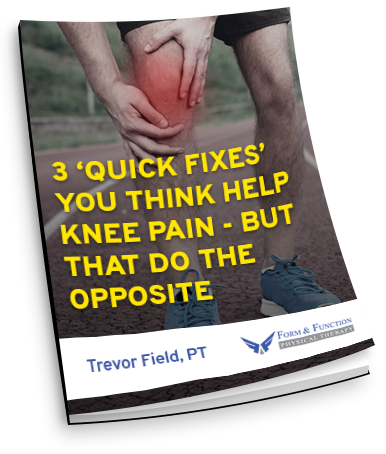A Physical Therapist’s Guide to Balance Problems
adapted from “GUIDE: Physical Therapy Guide to Balance Problems.”
I’m guessing you were searching “physical therapy for balance problems” on google it probably brought you here and that because this is my breakdown of the basics of what you need to know for dealing with balance issues and gaining some general understanding of them.
Balance problems make it hard for people to maintain stable posture and stay upright when standing, walking, and even sitting. Balance problems are more common as we age and are the most common reason they seek help from a doctor later in life. If balance problems go untreated, they can lead to falls. Physical therapists can help people of all ages improve their balance. PTs perform balance testing and develop treatment plans that include physical activity to help improve the strength, stability, and movement of people with balance problems.
Physical therapists are movement experts. They improve quality of life through hands-on care, patient education, and prescribed movement.
What Causes Balance Problems?
A balance problem exists when a person has difficulty keeping a stable and upright body position, whether moving or staying still. There are many causes of balance problems, including:
- Muscle weakness.
- Joint stiffness and decreased movement.
- Inner ear problems.
- Certain medicines
- Lack of physical activity or too much sitting.
- Simple aging.
Balance problems also can be caused by medical conditions, such as:
- Stroke.
- Parkinson disease.
- Multiple sclerosis.
- Traumatic brain injury.
- Arthritis.
- Spinal cord injury.
- Cognitive diseases (conditions that affect learning or thinking).
- Diabetes.
Balance problems occur when one or more of these five systems in the body do not function properly:
- Vision. Poor vision can result from age, eye tracking problems, or eye diseases.
- Inner ear. The part of the inner ear responsible for balance is the vestibular system. Hence, inner ear problems that affect a person’s balance are also called vestibular problems. Inner ear problems can develop from trauma, aging, poor nutrition, or disease.
- Muscular system. Muscle strength and flexibility can decline due to lack of exercise, too much sitting, or disease.
- Proprioception (the awareness of one’s own body position). Body-position sense can become abnormal due to trauma or a disease, such as diabetes.
- Circulation. A sudden drop in blood pressure when a person sits or stands up, called orthostatic hypotension, can make a person feel dizzy or lightheaded. This may cause a person to faint and fall. Circulation problems can be caused by heart problems, dehydration, and some diseases.
The brain receives and combines information from the eye, inner ear, and body-position senses for balance control. It then sends signals to muscles to move or adjust to stay balanced. A person may not be able to maintain or correct their balance if:
- One or more of the senses is not sending correct signals to the brain.
- The muscles cannot carry out the movements.
How Does It Feel?
A person with balance problems may experience:
- Teetering when trying to stand up, or staggering, tripping, swaying, or stumbling when walking.
- Dizziness or vertigo (a spinning feeling).
- Falling or feeling as if you are going to fall.
- Lightheadedness, faintness, or a floating sensation.
- Blurred vision.
Some people’s balance may be fine when sitting or standing still. This is called static balance. Balance also may be fine when only doing one thing at a time. Problems occur more often with dynamic balance, when a person moves about or tries to do more than one thing at a time. Dynamic balance problems also occur when information from the eye, inner ear, and body-position senses is altered. Examples include:
- Walking while turning the head to talk to another person.
- Bending and reaching for an object.
- Walking in poorly-lit places (at night, or in a darkened room).
If a person’s static or dynamic balance is abnormal, they can easily fall, and have a higher risk for injury.
Balance problems can make people fear doing simple daily activities. As a result, they may avoid movements they deem hard or that challenge their muscles. This will cause them to sit too much. This lack of movement leads to weakness that makes balance problems worse. A person who has balance problems also may feel frustration about their condition and become depressed.
How Is It Diagnosed?
If you see a physical therapist first, they will conduct a full evaluation that includes taking your health history. Your physical therapist also will ask you detailed questions about your condition, such as:
- How often do you have problems with your balance?
- What are you doing when you experience balance problems?
- Is your balance worse at night or in dark rooms?
- Does the room spin, or do you feel off-balance?
- How many times have you fallen in the past year?
- Has falling caused an injury or a visit to the doctor or hospital?
- Have you changed or limited any activities because of your balance problems?
- What medications do you take?
- Have you had a vision or ear checkup recently?
- Do you ever feel lightheaded, or as if you might faint?
- Do you have trouble doing any daily activities?
- How much, and what kind of, daily exercise do you get?
- Do you have any other medical conditions or problems?
- Are you under the care of a doctor?
- What are your goals?
Your physical therapist will perform tests to check your overall physical ability in areas such as:
- Movement.
- Strength.
- Coordination.
- Visual tracking.
- Balance.
Your physical therapist may team with your doctor or other health care providers, who may order further tests to rule out other conditions.
How Can a Physical Therapist Help?
Physical therapists offer many options to treat balance problems, based on each person’s needs. They evaluate many systems of the body, including
- Muscles and joints.
- The inner ear.
- Eye tracking ability.
- Skin sensation.
- Proprioception (position awareness in the joints).
- Circulation.
Physical therapists are movement experts who prescribe active movement techniques and physical exercise to improve these systems. Exercises may include those for:
- Strengthening.
- Stretching.
- Position awareness.
- Visual tracking.
- Inner ear retraining.
Your physical therapist can identify, diagnose, and help treat your balance problems by identifying their causes. They will design a treatment program specific to your needs, challenges, and goals. They also will provide you with exercises you can do at home. Your treatment plan may include strategies to:
- Reduce falls risk. Your physical therapist will assess problem footwear and hazards in your home that increase your risk of balance problems or falling. Hazards can include loose rugs, poor lighting, pets under foot, or other obstacles.
- Reduce the fear of falling. By addressing specific problems that are found during your examination, your physical therapist will help you regain confidence in your balance. They will help you improve your ability to move freely and do daily activities. As you build confidence in your balance and physical ability, you will be better able to enjoy everyday activities.
- Improve mobility. Your physical therapist will help you regain the ability to move around with more ease, coordination, and confidence. They will develop a personalized treatment and exercise program to gradually build your strength and movement skills.
- Improve balance. Your physical therapist will teach you exercises for both static balance (sitting or standing still) and dynamic balance (keeping your balance while moving and doing daily activities). They also may work with you on exercises to improve your ability to react to a balance disturbance to prevent a fall. They will increase these exercises gradually as your skills improve to help you progress.
- Improve strength. Your physical therapist will teach you exercises to address muscle weakness, or to improve your overall muscle strength. Strengthening muscles in the trunk, hip, and stomach (core) can be especially important to improve balance. They may use exercise bands for resistance training to improve your strength and avoid joint stress.
- Improve movement. Your physical therapist will choose specific activities and treatments to help restore normal movement in any stiff joints. These might begin with passive motions that the physical therapist does for you, and progress to active exercises that you do yourself.
- Improve flexibility and posture. Your physical therapist will determine if any of your major muscles are tight. They will teach you how to gently stretch them. Your physical therapist also will assess your posture, and teach you exercises to improve your ability to keep a proper posture. Good posture can improve your balance.
- Increase activity levels. Your physical therapist will discuss activity goals with you. They will design an exercise program to address your specific needs and goals. Your physical therapist will help you reach those goals in the safest, fastest, and most effective way possible.
Can This Injury or Condition Be Prevented?
To help prevent balance problems, your physical therapist will likely advise you to:
- Keep moving. Avoid a lifestyle that involves too much sitting. Do a challenging physical activity each day to keep your muscles strong and flexible, and your heart and lungs strong. Use your body as much as you can to do activities like:
- Walking, cycling, or swimming.
- Climbing stairs instead of using an elevator.
- Gardening, mowing the lawn, and cooking.
- Washing dishes by hand, folding laundry, or making the bed.
- Other daily activities that keep you moving.
If you work out or follow a fitness program, keep it up!
- Get yearly checkups for vision and hearing. Make sure your vision prescription is up to date.
- Carefully manage chronic diseases like diabetes. Long-term side effects can include balance problems. You can greatly reduce the side effects by following the recommended diet, physical activity, and medicine guidelines given to you by your doctor.
- Mind your medicines. Make note of any medicines that you think may be affecting your balance and talk to your doctor about them.
- Report any falls to your doctor and physical therapist immediately. They will evaluate and address the possible causes.
Your physical therapist also will prescribe a home exercise program specific to your needs to prevent future problems or injuries. This program may include:
- Strength and flexibility exercises.
- Posture retraining.
- Exercises for eye tracking and inner ear function.
- Balance exercises.
If you are experiencing falls, your physical therapist may instruct you on how to use a cane or walker to allow you to keep moving safely.
What Kind of Physical Therapist Do I Need?
All physical therapists are prepared through education and experience to manage balance problems. However, you may want to consider:
- A physical therapist with experience in treating people with balance or vestibular problems. Some physical therapists have a practice with a focus on treating older adults or people with balance or (vestibular) inner ear problems.
- A physical therapist who completed special training in vestibular physical therapy. This physical therapist has advanced knowledge, experience, and skills that may apply to your condition.
If you need to find a skilled, hands-on Physical Therapist that deals with balance problems and vertigo well look no further! We are the best in the Inland Empire and you don’t just have to take our word for it… Check out our reviews on Google
And if you are ready to find out a little bit more about us…
Check out our latest Episode of the Stay In The Game Podcast where I talk about some of the most common issues around balance and vertigo.
Powered by RedCircle
Avruskin, Andrea. “GUIDE: Physical Therapy Guide to Balance Problems.” Choose PT, 26 Aug. 2021, https://www.choosept.com/guide/physical-therapy-guide-balance-problems.





